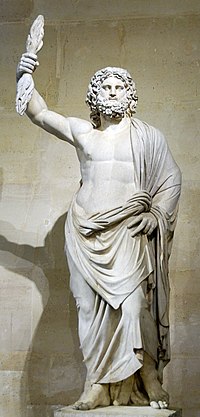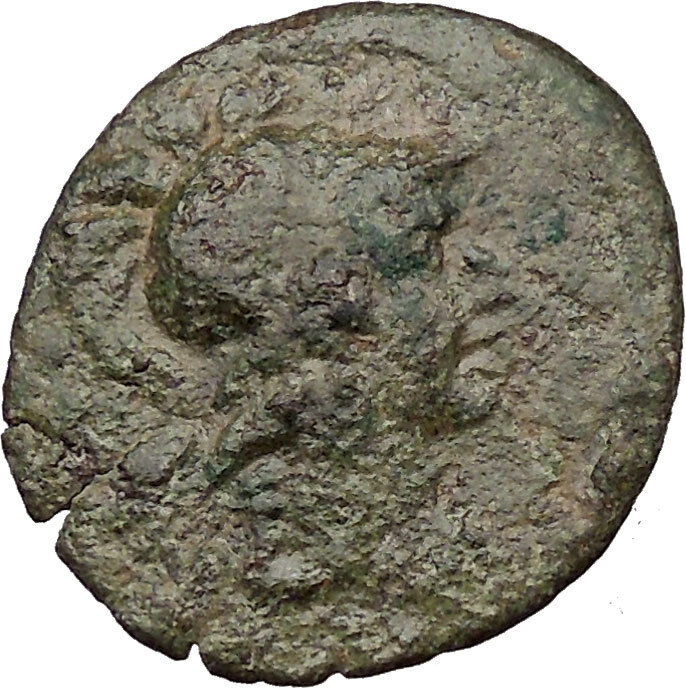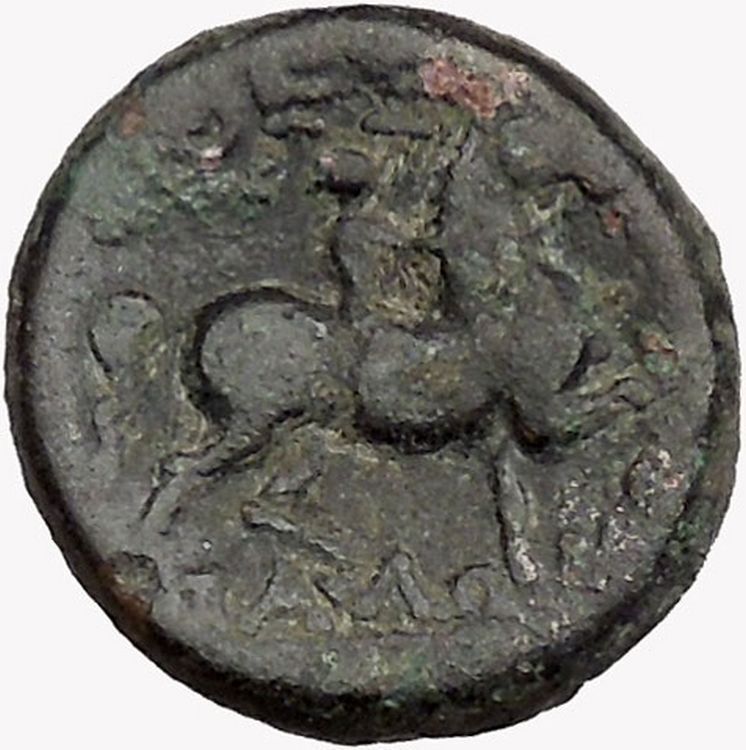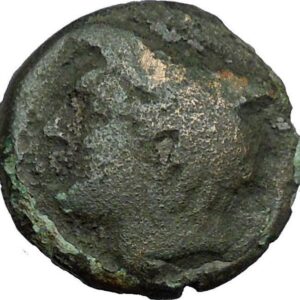|
Greek city of Mopsos in Cilicia
Bronze 21mm (6.30 grams) Struck 2nd-1st centuries B.C.
Reference: Sear 5575; SNG BN 1952-7
Laureate and draped bust of Zeus right.
MOΨEATΩN, Lighted altar; monogram to left and right.
Mopsos was situated on the river Pyramos, north-east of Mallos, the city was name after the brother of Amphilochos. During the reign of Antiochos IV of the Seleukid empire, it bore the name of Seleukeia.
You are bidding on the exact item pictured, provided with a Certificate of Authenticity and Lifetime Guarantee of Authenticity.
 In the ancient Greek religion, Zeus was the “Father of Gods and men” who ruled the Olympians of Mount Olympus as a father ruled the family. He was the god of sky and thunder in Greek mythology. His Roman counterpart is Jupiter and Etruscan counterpart is Tinia. In the ancient Greek religion, Zeus was the “Father of Gods and men” who ruled the Olympians of Mount Olympus as a father ruled the family. He was the god of sky and thunder in Greek mythology. His Roman counterpart is Jupiter and Etruscan counterpart is Tinia.
Zeus was the child of Cronus and Rhea, and the youngest of his siblings. In most traditions he was married to Hera, although, at the oracle of Dodona, his consort was Dione: according to the Iliad, he is the father of Aphrodite by Dione. He is known for his erotic escapades. These resulted in many godly and heroic offspring, including Athena, Apollo and Artemis, Hermes, Persephone (by Demeter), Dionysus, Perseus, Heracles, Helen of Troy, Minos, and the Muses (by Mnemosyne); by Hera, he is usually said to have fathered Ares, Hebe and Hephaestus.
As Walter Burkert points out in his book, Greek Religion, “Even the gods who are not his natural children address him as Father, and all the gods rise in his presence.” For the Greeks, he was the King of the Gods, who oversaw the universe. As Pausanias observed, “That Zeus is king in heaven is a saying common to all men”. In Hesiod’s Theogony Zeus assigns the various gods their roles. In the Homeric Hymns he is referred to as the chieftain of the gods.
His symbols are the thunderbolt, eagle, bull, and oak. In addition to his Indo-European inheritance, the classical “cloud-gatherer” also derives certain iconographic traits from the cultures of the Ancient Near East, such as the scepter. Zeus is frequently depicted by Greek artists in one of two poses: standing, striding forward, with a thunderbolt leveled in his raised right hand, or seated in majesty.
 Mopsuestia (Greek: Μοψουεστία Mopsou(h)estia; Byzantine: Mamista, Manistra; Arabic: al-Maṣṣīṣah; Armenian: Msis, Mises, Mam(u)estia; Frankish: Mamistra) is an ancient city in Cilicia Campestris on the Pyramus River (now Ceyhan River) located approximately 20 km (12 mi) east of ancient Antiochia in Cilicia (present-day Adana, southern Turkey). From the city’s harbour the river is navigable to the Mediterranean Sea, a distance of over 40 km (24 mi). Mopsuestia (Greek: Μοψουεστία Mopsou(h)estia; Byzantine: Mamista, Manistra; Arabic: al-Maṣṣīṣah; Armenian: Msis, Mises, Mam(u)estia; Frankish: Mamistra) is an ancient city in Cilicia Campestris on the Pyramus River (now Ceyhan River) located approximately 20 km (12 mi) east of ancient Antiochia in Cilicia (present-day Adana, southern Turkey). From the city’s harbour the river is navigable to the Mediterranean Sea, a distance of over 40 km (24 mi).
The founding of this city is attributed in legend to the soothsayer Mopsus, who lived before the Trojan war, although it is scarcely mentioned before the Christian era. Pliny the Elder calls it the free city of Mopsos (Hist. nat., V, 22), but the ordinary name is Mopsuestia, as found in Stephanus of Byzantium and all the Christian geographers and chroniclers. Under the Seleucid Empire, the city took the name of Seleucia on the Pyramus (classical Greek: Σελεύκεια πρὸς τὸν Πύραμον, Seleukeia pros ton Pyramon; Latin: Seleucia ad Pyramum), but gave it up at the time of the Roman conquest; under Hadrian it was called Hadriana, under Decius Decia, etc., as we know from the inscriptions and the coins of the city. Constantius II built there a magnificent bridge over the Pyramus (Malalas, Chronographia, XIII; P.G., XCVII, 488) afterwards restored by Justinian (Procopius, De Edificiis, V. 5) and has been restored again recently.
Christianity seems to have been introduced very early into Mopsuestia and during the 3rd century there is mention of a bishop, Theodorus, the adversary of Paul of Samosata. Other famous residents of the early Christian period in the city’s history include Saint Auxentius (d. 360), and Theodore, bishop from 392�”428, the teacher of Nestorius. The bishopric is included in the Catholic Church’s list of titular sees. Along with much of Cilicia, the region was wrested from Roman control by the Arabs in the late 630s.
In 684 the Emperor Constantine IV recaptured Misis from its small Arab garrison and it remained an imperial possession until 703 (Theophanes, “Chronogr.”, A. M. 6178, 6193), when it was recaptured by ̔the Arabs, who rebuilt the fortifications, constructed a mosque, and maintained a permanent garrison. Because of its position on the frontier, the city was repeatedly fought over and was recaptured from time to time by the Byzantines: it was besieged in vain by the Byzantine troops of John I Tzimisces in 964, but was taken the following year after a long and difficult siege by Nicephorus Phocas.
Mopsuestia then numbered 200,000 inhabitants, some of whom were Muslim, and the Byzantines made efforts to re-Christianize the city. In the early 1090s Turkish forces overran the town, but were expelled in 1097 by Crusader troops under Tancred who took possession of the city and its strategic port, which were annexed to the Principality of Antioch. It suffered much from internecine war between Crusaders, Armenians, and Greeks who lost it and recaptured it, notably in 1106, 1132, and 1137. Finally in 1151-52 the Armenian Baron T’oros II captured the city and defeated the Greek counter attack led by Andronikos I Komnenos. Thereafter it remained a possession of the Armenian Kingdom of Cilicia, but was briefly captured and plundered by the Mamluks in 1266, 1275, and 1322. The Venetians and Genoese were licensed by the Armenians to maintain warehouses near the harbour to store goods brought from India. The Armenians were permanently evicted by the Mamluks in 1347. The city was the site of several church councils and possessed four Armenian churches; the Greek diocese still existed at the beginning of the fourteenth century (Le Quien, Oriens Christianus, II, 1002 ). In 1432 the Frenchman Bertrandon reported that he city was ruled by the Muslims and was largely destroyed. In 1515 Mopsuestia, and the whole of Cilica, was incorporated into the Ottoman Empire by Sultan Selim I. Since then it has steadily declined and became the small village of Misis. Misis was renamed Yakapınar in the 1960s. Only fragments of the medieval fortifications survive today. However, an etching of the circuit walls and towers was made in the mid-19th century. The Misis Mosaic Museum was founded in 1959 to exhibit the mosaics found in the area, including the famous “Samson Mosaic.”
In antiquity, Cilicia was the south coastal region of Asia Minor and existed as a political entity from Hittite times into the Armenian Kingdom of Cilicia during the late Byzantine Empire. Extending inland from the southeastern coast of modern Turkey, Cilicia is due north and northeast of the island of Cyprus and corresponds to the modern region of Çukurova in Turkey.

|





 In the ancient Greek religion, Zeus was the “Father of Gods and men” who ruled the Olympians of Mount Olympus as a father ruled the family. He was the god of sky and thunder in Greek mythology. His Roman counterpart is Jupiter and Etruscan counterpart is Tinia.
In the ancient Greek religion, Zeus was the “Father of Gods and men” who ruled the Olympians of Mount Olympus as a father ruled the family. He was the god of sky and thunder in Greek mythology. His Roman counterpart is Jupiter and Etruscan counterpart is Tinia. Mopsuestia (Greek: Μοψουεστία Mopsou(h)estia; Byzantine: Mamista, Manistra; Arabic: al-Maṣṣīṣah; Armenian: Msis, Mises, Mam(u)estia; Frankish: Mamistra) is an ancient city in Cilicia Campestris on the Pyramus River (now Ceyhan River) located approximately 20 km (12 mi) east of ancient Antiochia in Cilicia (present-day Adana, southern Turkey). From the city’s harbour the river is navigable to the Mediterranean Sea, a distance of over 40 km (24 mi).
Mopsuestia (Greek: Μοψουεστία Mopsou(h)estia; Byzantine: Mamista, Manistra; Arabic: al-Maṣṣīṣah; Armenian: Msis, Mises, Mam(u)estia; Frankish: Mamistra) is an ancient city in Cilicia Campestris on the Pyramus River (now Ceyhan River) located approximately 20 km (12 mi) east of ancient Antiochia in Cilicia (present-day Adana, southern Turkey). From the city’s harbour the river is navigable to the Mediterranean Sea, a distance of over 40 km (24 mi).





